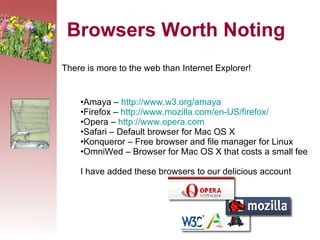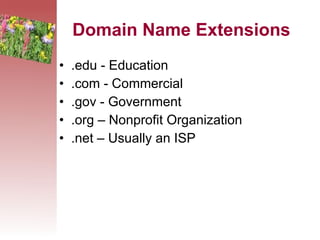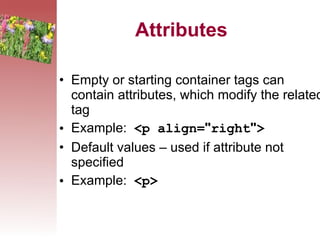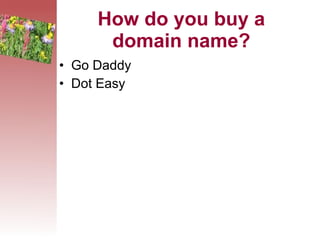2 Html Intro
- 1. Web Terminology Presented by: Dawn Rauscher September 9, 2008
- 2. Discussion Topics What is HTML? Web Browsers URL HTML Terminology File Transfer Protocol (FTP) Questions & Answers
- 3. Portable across platforms Write the code in a document using a text-editor program View the page in a browser In Dreamweaver choose Code view to view the HTML code XHTML ( Hyper Text Markup Language)
- 4. The World Wide Web Purpose for Communication Internet is vast network that connects computers all over the world World Wide Web 1990 & 1991 was created by Tim Berners-Lee ( WWW ). A hypermedia-based system for browsing Internet sites. It is named the Web because it is made of many sites linked together; users can travel from one site to another by clicking on hyperlinks. Text, graphics, sound, and video can all be accessed with browsers like Mosaic, Netscape, or Internet Explorer.
- 5. Browsers Which one should I use? 1994 Netscape released Navigator Navigator controlled 75% of the market 1996 Microsoft came out with Explorer and the wars began Browser Statistics When developing Web pages -- it is very important to check Your web sites in as many browsers as possible. Is one better than the other?
- 6. Browsers Worth Noting There is more to the web than Internet Explorer! Amaya – http://www.w3.org/amaya Firefox – http://www. mozilla . com/en-US/firefox/ Opera – http://www.opera.com Safari – Default browser for Mac OS X Konqueror – Free browser and file manager for Linux OmniWed – Browser for Mac OS X that costs a small fee I have added these browsers to our delicious account
- 7. HTML Hypertext Markup Language XHTML is a simple language Used to create Web pages that appear on World Wide Web Based on an older language SGML: Standard Generalized Markup Language HTML originally designed to define elements in a document independent of how they would appear XHTML now capable of defining how elements should appear in a browser
- 8. Cascading Style Sheets (CSS) HTML lacks a proper means of influencing the display of content - It was intended to provide structure. CSS was introduced in the late 1990’s CSS describes how HTML documents should be visually presented while leaving the structural markup clean and meaningful.
- 9. Benefits of CSS Style sheets can be applied to any HTML document adding an attractive layer of visual design Separating content from presentation allows both aspects to become stronger and more adaptable. An entire Web site can be redesigned by changing a single style sheet Today’s browsers support CSS!
- 10. URL (Uniform Resource Locator) Internet Address of a resource The address that allows a web-connected device to locate a specific file on a specific server in order to download and display it to the user. Protocol://domain name/path/filename Yahoo URL – http://www.yahoo.com Protocol Domain Name
- 11. First part of the URL Describes the format of the information accessed from the Internet http: (links that point to other web pages) file: (file you want browser to read) ftp: (download or copy a file to a computer) mailto: (Start a mail program) telnet: (login remotely to a specified computer) URL (Uniform Resource Locator)
- 12. Domain Name Second Part of the URL Physical location of the file or resource IP Address – 198.95.251.5 Domain Name – yahoo.com Domain Name Server (DNS) will translate domain name into the IP address
- 13. Domain Name Extensions .edu - Education .com - Commercial .gov - Government .org – Nonprofit Organization .net – Usually an ISP
- 14. New Extensions .aero – Air Transport Industry .biz – Business .coop – Cooperatives .info – Unrestricted .museum – Museums .name – Personal Applications .pro – Professionals such as accountants, doctors, and lawyers
- 15. Path and FileName Example – http://home1.fvcc.edu/~drausche/cmpa270/calendar.htm
- 16. Basic HTML Syntax HTML documents are text documents Contain formatting instructions, called tags All HTML documents must use the <html> element as the root element A root element contains all the other elements in a document Opening and closing <html>...</html> tags are required Two other important HTML elements are the <head> element and the <body> element
- 17. Basic Syntax
- 18. Attributes Empty or starting container tags can contain attributes, which modify the related tag Example: <p align= " right " > Default values – used if attribute not specified Example: <p>
- 19. HTML Example <!DOCTYPE HTML PUBLIC "-//W3C//DTD HTML 4.01 Transitional//EN" "http://www.w3.org/TR/html401/loose.dtd"> <html> <head> <title>Welcome to My Web Site!</title> </head> <body> <h1>Dawn Rauscher</h1> <p> I teach at FVCC </p> </body> </html>
- 20. How do you buy a domain name? Go Daddy Dot Easy
- 21. Questions?




















